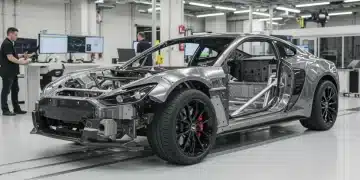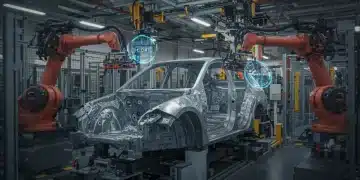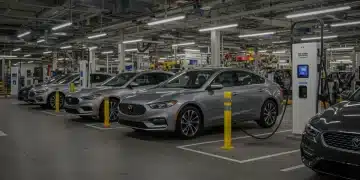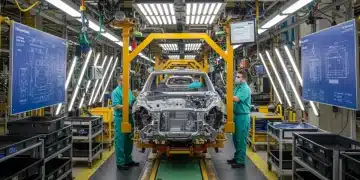Sustainable Materials in Automotive Production: 4 Key Trends for US Market Adoption in 2025
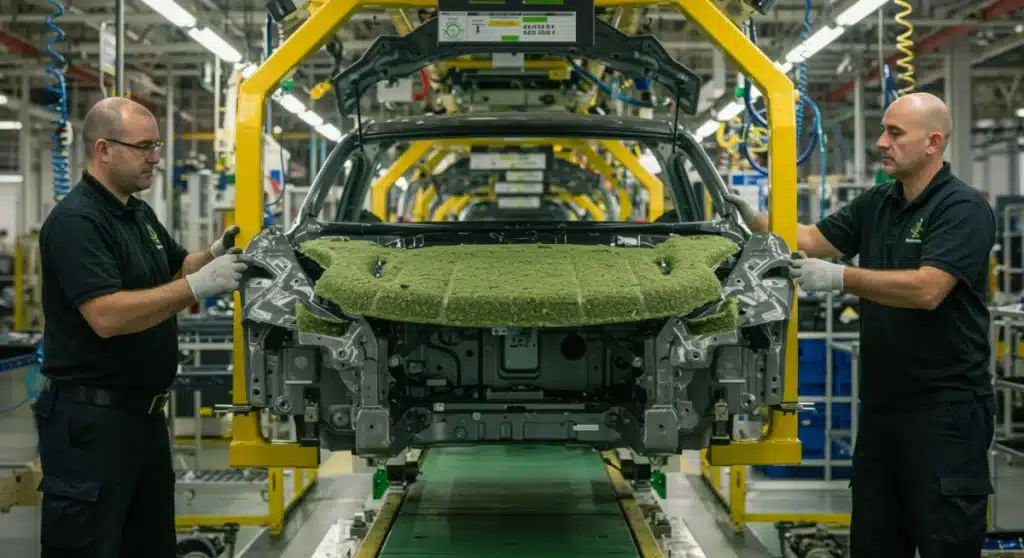
The US automotive industry is accelerating its transition to sustainable materials, with 2025 poised to see widespread adoption of bio-based composites, advanced recycled plastics, lightweighting innovations, and circular economy models.
The automotive industry is in constant motion, and as of late, a significant shift toward environmental responsibility is redefining manufacturing processes. This includes a strong focus on Sustainable Materials in Automotive Production: 4 Key Trends for US Market Adoption in 2025, which are now emerging as critical drivers for innovation and competitive advantage. What are these trends, and how will they reshape the vehicles we drive?
The Rise of Bio-Based Composites and Natural Fibers
The push for greener vehicles extends beyond powertrains to the very materials they are built from. Bio-based composites and natural fibers are rapidly gaining traction in the US automotive sector, offering a compelling alternative to traditional petroleum-derived plastics and metals. Manufacturers are increasingly looking to integrate these materials to reduce their carbon footprint and improve vehicle sustainability profiles.
Recent developments indicate a heightened interest in materials derived from renewable resources. Companies are investing in research and development to scale up production and overcome previous limitations related to durability and cost. This trend is not just about environmental benefits; it also includes performance enhancements like reduced weight, which directly impacts fuel efficiency and electric vehicle range.
Flax and Hemp: New Staples in Automotive Interiors
Natural fibers such as flax and hemp are becoming prevalent in interior components. These materials offer excellent strength-to-weight ratios and acoustic dampening properties, making them ideal for door panels, seat backs, and parcel shelves. The adoption is driven by both regulatory pressures and consumer demand for more eco-friendly products.
- Reduced Weight: Natural fibers are generally lighter than traditional materials, contributing to better fuel economy or extended EV range.
- Lower Carbon Footprint: Growing natural fibers sequesters carbon, and their processing often requires less energy than synthetic alternatives.
- Improved Acoustics: These materials can help reduce cabin noise, enhancing passenger comfort.
- Renewable Resource: Unlike fossil fuels, these plants can be regrown, ensuring a continuous supply.
Advanced Recycling Technologies for Automotive Plastics
With an ever-increasing volume of vehicles reaching end-of-life, the automotive industry faces a significant challenge in waste management. Advanced recycling technologies are emerging as a pivotal solution, transforming what was once waste into valuable resources for new vehicle production. This shift is crucial for achieving a circular economy within the sector, moving away from a linear ‘take-make-dispose’ model.
Chemical recycling, in particular, is drawing considerable attention. This process breaks down plastics into their basic molecular components, allowing them to be re-polymerized into new, high-quality plastics that are indistinguishable from virgin materials. This offers a distinct advantage over mechanical recycling, which often results in downcycled materials with reduced properties. The US market is seeing substantial investment in these technologies, with several pilot plants and commercial-scale facilities expected to come online by 2025.
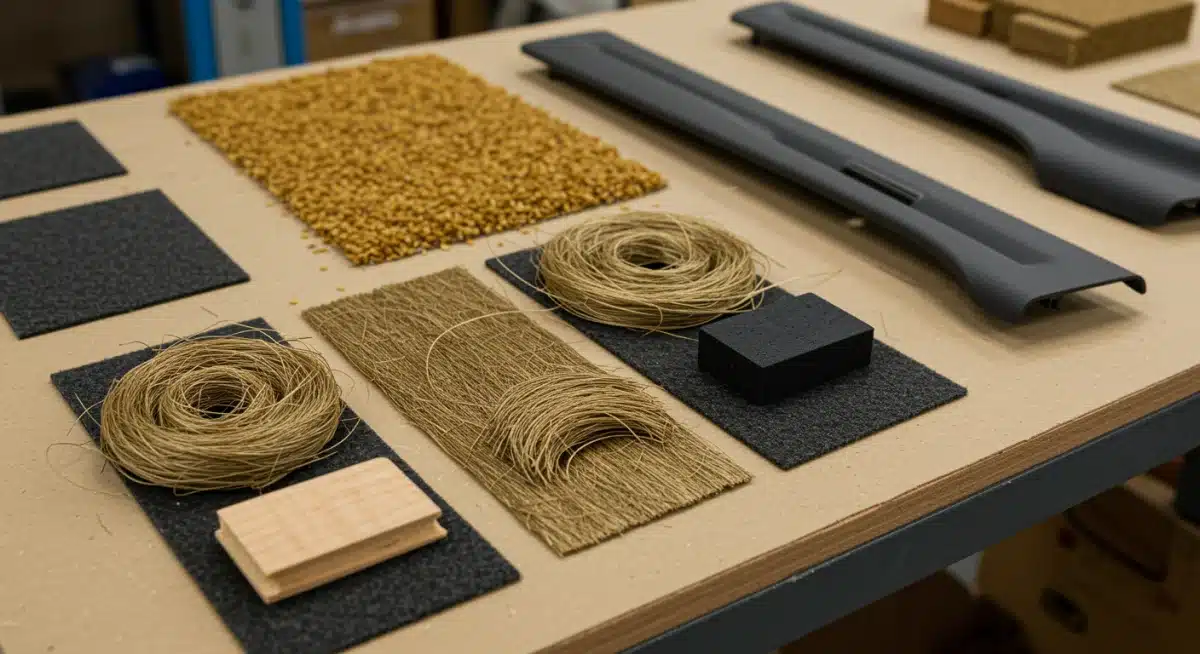
Chemical Recycling: A Game Changer for Polymers
Chemical recycling holds the promise of infinitely recyclable plastics for automotive applications. This includes challenging plastics like mixed waste streams and highly contaminated materials that are difficult to process mechanically. The resulting recycled content can be used in a wide range of components, from under-the-hood parts to interior trim.
- High-Quality Output: Produces recycled plastics with properties comparable to virgin materials.
- Wider Material Scope: Can process a broader range of plastic waste, including mixed and contaminated streams.
- Reduced Virgin Material Demand: Lessens reliance on new fossil fuel-derived plastics.
- Circular Economy Enabler: Facilitates a closed-loop system for plastic use in automotive manufacturing.
Lightweighting Innovations with Sustainable Metals
Lightweighting has long been a critical strategy for improving vehicle efficiency, and its importance is only growing with the rise of electric vehicles, where every kilogram impacts range. However, the focus is now shifting to achieving weight reduction through sustainable means, utilizing advanced metals and alloys that have a lower environmental footprint throughout their lifecycle. This involves both the use of recycled content and the development of new, resource-efficient production methods.
The US automotive industry is actively exploring novel aluminum alloys, high-strength steels, and magnesium components that offer superior performance while being more sustainable. These materials are often produced using processes that reduce energy consumption and greenhouse gas emissions. The integration of these advanced materials is complex, requiring significant engineering innovations in design and manufacturing to ensure safety and durability standards are met.
Recycled Aluminum and Advanced Steel Alloys
Recycled aluminum is a prime example, requiring significantly less energy to produce than primary aluminum. Similarly, advancements in high-strength steel alloys allow for thinner gauges without compromising structural integrity, leading to substantial weight savings. These materials are not just about being lighter; they are about being smarter in their application and production.
- Energy Savings: Producing recycled aluminum consumes up to 95% less energy than primary aluminum.
- Weight Reduction: High-strength steels and advanced alloys enable thinner, lighter components.
- Enhanced Performance: Maintain or improve crash safety and structural rigidity despite being lighter.
- Resource Efficiency: Reduces the need for virgin ore extraction and associated environmental impacts.
Circular Economy Principles in Automotive Manufacturing
The concept of a circular economy is gaining significant traction within the US automotive industry, moving beyond simply recycling materials to designing products for longevity, repairability, and ultimate end-of-life recovery. This holistic approach aims to keep resources in use for as long as possible, extracting maximum value from them, and then recovering and regenerating products and materials at the end of each service life. By 2025, many manufacturers are targeting substantial integration of these principles into their core operations.
This paradigm shift involves rethinking every stage of a vehicle’s life cycle, from initial design to manufacturing, use, and eventual decommissioning. It requires collaboration across the supply chain, from material suppliers to component manufacturers and recyclers. The goal is to minimize waste, reduce resource consumption, and mitigate environmental impacts throughout the entire value chain. This is a complex undertaking but promises long-term economic and environmental benefits.
Design for Disassembly and Material Reutilization
One key aspect of the circular economy is designing vehicles with future disassembly and material reutilization in mind. This means using fewer types of materials, making them easier to separate, and ensuring they are compatible with recycling processes. Manufacturers are also exploring modular designs that allow for easier repair and upgrades, extending the lifespan of vehicles.
- Product Longevity: Designing for durability and repairability extends vehicle lifespans.
- Material Recovery: Facilitates easier and more efficient recovery of materials at end-of-life.
- Waste Reduction: Minimizes landfill waste and incineration by keeping materials in circulation.
- Resource Independence: Reduces reliance on finite virgin resources, enhancing supply chain resilience.
Supplier Collaboration and Transparency in the Supply Chain
The success of integrating Sustainable Materials in Automotive Production: 4 Key Trends for US Market Adoption in 2025 hinges significantly on robust collaboration and unprecedented transparency across the entire supply chain. Automakers cannot achieve their sustainability goals in isolation; they must work closely with their suppliers to ensure that materials meet environmental criteria, ethical sourcing standards, and performance specifications. This collaborative effort is becoming a cornerstone of sustainable manufacturing.
As of now, leading automotive companies are implementing more stringent supplier codes of conduct and engaging in joint development projects to innovate new sustainable materials and processes. This includes tracing the origin of raw materials to prevent issues like deforestation or unethical labor practices, and ensuring that component manufacturing adheres to environmental best practices. The transparency demanded by consumers and regulators alike is driving this push for greater accountability throughout the supply chain.
Establishing Sustainable Sourcing Standards
Establishing clear and verifiable sustainable sourcing standards is paramount. This involves setting benchmarks for carbon emissions, water usage, and waste generation at every tier of the supply chain. Audits and certifications are becoming common tools to ensure compliance and provide verifiable data on environmental performance. This proactive approach helps mitigate risks and builds trust with consumers who are increasingly concerned about a product’s environmental and social impact.
- Ethical Sourcing: Ensures materials are procured responsibly, free from human rights abuses or environmental damage.
- Environmental Compliance: Verifies that suppliers meet or exceed environmental regulations and sustainability targets.
- Innovation Partnerships: Fosters joint development of new sustainable materials and manufacturing techniques.
- Risk Mitigation: Reduces supply chain disruptions related to environmental or social governance issues.
Regulatory Landscape and Consumer Demand Fueling Adoption
The accelerated adoption of Sustainable Materials in Automotive Production: 4 Key Trends for US Market Adoption in 2025 is not merely an industry-driven initiative; it is significantly propelled by an evolving regulatory landscape and escalating consumer demand. Governments in the US, both federal and state, are introducing stricter emissions standards and promoting policies that incentivize sustainable manufacturing practices. These regulations create a compelling framework for automakers to innovate and integrate eco-friendly materials.
Simultaneously, consumer awareness and preference for sustainable products are at an all-time high. A growing segment of car buyers is actively seeking vehicles that not only perform well but also align with their environmental values. This dual pressure from both regulatory bodies and the marketplace is creating an undeniable momentum for the shift towards sustainable materials, transforming it from a niche consideration to a mainstream imperative for the US automotive industry.
Government Incentives and Consumer Preferences
Government incentives, such as tax credits for electric vehicles or mandates for recycled content, play a crucial role in making sustainable options more economically viable for manufacturers and consumers. On the consumer side, surveys consistently show a willingness to pay a premium for products with verifiable sustainability credentials. This market signal is a powerful motivator for automotive brands to highlight their eco-friendly material choices.
- Policy Drivers: Regulations and incentives from government bodies push for greener manufacturing.
- Market Demand: Consumers increasingly prioritize sustainability in their purchasing decisions.
- Brand Reputation: Adopting sustainable materials enhances a brand’s image and appeal.
- Competitive Advantage: Early adopters gain a lead in a rapidly evolving, eco-conscious market.
| Key Trend | Brief Description |
|---|---|
| Bio-Based Composites | Utilization of natural fibers like flax and hemp for interior components, reducing weight and carbon footprint. |
| Advanced Recycling | Chemical recycling processes that transform plastic waste into high-quality, reusable materials for new vehicles. |
| Lightweight Sustainable Metals | Adoption of recycled aluminum and advanced high-strength steels to reduce vehicle weight and energy consumption. |
| Circular Economy Principles | Designing vehicles for longevity, repairability, and complete material recovery at end-of-life. |
Frequently Asked Questions About Sustainable Automotive Materials
Bio-based composites are materials derived from renewable resources like plant fibers (e.g., flax, hemp) combined with resins. They are used in car parts to reduce reliance on petroleum-based plastics, offering benefits like lighter weight and a lower carbon footprint, particularly in interior components.
Advanced recycling, especially chemical recycling, allows the automotive industry to break down mixed plastic waste into its molecular components. This enables the creation of new, high-quality plastics comparable to virgin materials, fostering a circular economy and reducing landfill waste from end-of-life vehicles.
Lightweighting is crucial for sustainable vehicles because it directly improves fuel efficiency in internal combustion engine cars and extends the range of electric vehicles. By using lighter, sustainable materials like recycled aluminum and advanced steels, automakers reduce energy consumption during both vehicle operation and manufacturing.
Circular economy principles in automotive manufacturing focus on designing vehicles for durability, easy repair, and complete material recovery at end-of-life. The goal is to keep resources in use for as long as possible, minimizing waste and reducing the need for new raw materials throughout the vehicle’s lifecycle.
Both consumer demand for eco-friendly products and government regulations, such as stricter emissions standards and mandates for recycled content, significantly influence automotive material choices. This dual pressure drives manufacturers to adopt sustainable materials to meet market expectations and comply with environmental policies.
Looking Ahead
The rapid evolution in Sustainable Materials in Automotive Production: 4 Key Trends for US Market Adoption in 2025 marks the beginning of a structural shift in how the industry approaches Sustainable Material innovation. As automakers accelerate adoption, Sustainable Material integration moves beyond compliance and becomes a core pillar of vehicle development strategy.
The next stage of transformation will be defined by continuous investment in Sustainable Material research, strategic cross-industry collaborations, and stronger alignment between OEMs, suppliers, and policymakers. With supply chain resilience becoming a competitive advantage, securing access to critical inputs and developing Sustainable Material sourcing frameworks will be essential for long-term stability.
Industry analyses, like those presented by the National Academy of Engineering, emphasize the growing importance of responsible extraction, recycling technologies, and lifecycle optimization of each Sustainable Material used in production. These insights reinforce that sustainability is no longer just a marketing narrative — it is a technical and strategic mandate.
Looking forward, manufacturers that lead in Sustainable Material engineering will shape new industry standards, influence regulatory direction, and enhance brand positioning in a market increasingly driven by conscious consumer demand. The future of mobility will belong to those who treat Sustainable Material development not as an obligation, but as a competitive edge in automotive innovation.
